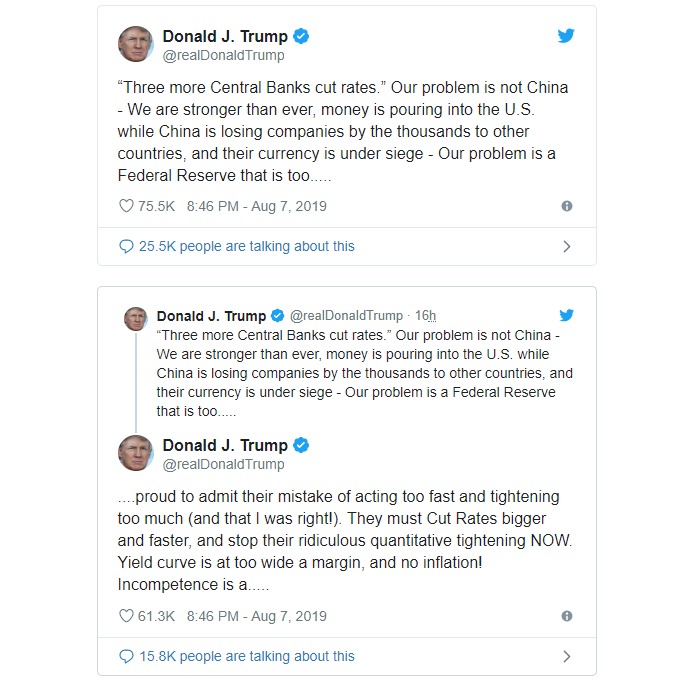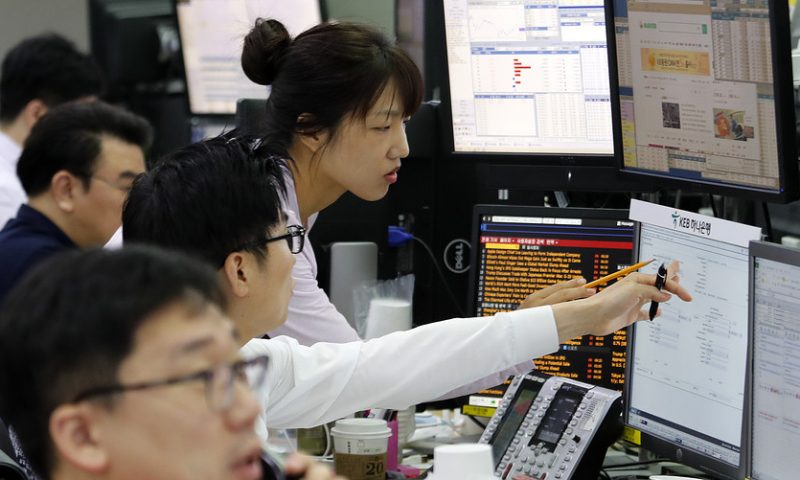Fed’s Evans sees another interest rate cut this year
U.S. stocks on Wednesday mustered modest gains following a dramatic turnabout, with all three key equity benchmarks recovering from losses of at least 1% which were partly driven by signs that global economic growth was slowing as the U.S. – China trade war intensifies.
How did benchmarks perform?
The Dow Jones Industrial Average DJIA, -0.09% finished 22.45 points lower, or less than 0.1%, to 26,007.07, after sinking 2.3% or 589 points, at the session low. The S&P 500 index SPX, +0.08% finished 2.21 points, or 0.1%, higher at 2,883.98, after skidding nearly 2%, while the Nasdaq Composite Index COMP, +0.38% gained 29.56 points, or 0.4% to 7,862.83, reversing an intraday 130-point slide in the technology-heavy index.
The reversal for the Dow and S&P 500 represents their biggest turnarounds since Dec. 27, 2018, according to Dow Jones Market Data.
On Tuesday, the Dow rose 311.78 points, or 1.2%, to end at 26,029.52, while the S&P 500 index climbed 37.03 points, or 1.3%, to close at 2.881.77, while the Nasdaq Composite Index COMP, +0.38% surged 107.23 points, or 1.4%, to finish at 7,833.27.
What’s driving the market?
U.S. equity markets shook off losses to turn higher late in a thinly traded summer market, with little substantive news to drive the afternoon ascent.
Stocks initially sank as U.S. Treasury and European government bonds yields plumbed fresh lows. The 10-year Treasury TMUBMUSD10Y, +2.84% fell below 1.70%, falling to an intraday nadir at 1.60%, around the lowest since late 2016, but were backing up in late-session trade Wednesday. Meanwhile, comparable German bonds TMBMKDE-10Y, -9.60% hit a record low at negative 0.59%.
“I don’t think there’s any exact headline or data point that turned the markets around but I think investors are becoming more rational about the economic environment we’re in,” Lindsey Bell, investment strategist at CFRA, told MarketWatch, referring to the domestic economy.
“We have a very strong consumer and things are on a solid footing,” Bell said.
J.J. Kinahan, chief market strategist at TD Ameritrade, said that the volatility of the day could be partially attributed to thin summer trading volumes. “A thinly-traded market can sometimes exacerbate moves, and August trading tends to be light – its typically a sleepy month,” he said.
Investors have been jittery about the prospects of a recession in the U.S. against a weakening economic backdrop around the world.
Adding to that sentiment, central banks in India and New Zealand (as well as Thailand) on Wednesday lowered their domestic interest rates to levels lower than had been expected, highlighting anxieties centered on the health of the world-wide economy.
India’s central bank cut its key interest rate for the fourth consecutive time, reducing the repo rate by 0.35% to 5.40% to shore up the economy, while New Zealand’s central bank cut its benchmark interest rate to an all-time low of 1% on Wednesday.
“Central banks in New Zealand, Thailand, and India all cut rates overnight and that highlights how concerned central bankers are about the state of the global economy,” wrote David Madden, market analyst at CMC Markets UK, in a Wednesday note.
In the U.S., Chicago Fed President Charles Evans on Wednesday said he wants to adjust monetary policy until it is giving the economy a slight boost. This means another quarter-point rate cut this year, he said, in a breakfast conversation with reporters, noting also that “more accommodation could be needed”.
Meanwhile, for a second day in a row overnight Tuesday, the People’s Bank of China set the official midpoint reference for yuan at 6.9996 in Asian hours, but the level is approaching 7 to the U.S. dollar, widely viewed as a line in the sand for the currency. The PBOC fixes the currency daily and allows it to move up to 2 percentage points on either side of its midpoint.
A breach of that level on Monday, interpreted by some as an intentional weakening of its currency, helped to ignite a global stock market selloff and slump in bond yields, but markets stabilized on Tuesday, despite the prospect of an uncertain timeline for a Sino-American trade resolution.
Losses for stocks Wednesday accelerated after President Donald Trump tweeted that the U.S’s “problem is not China – We are stronger than ever, money is pouring into the U.S. while China is losing companies by the thousands to other countries, and their currency is under siege – Our problem is a Federal Reserve that is too… proud to admit their mistake of acting too fast and tightening too much (and that I was right!).
The president said, the central bank “must cut rates bigger and faster, and stop their ridiculous quantitative tightening NOW,” he tweeted:

Which stocks are in focus?
The Walt Disney Co. DIS, -4.94% on Tuesday said beginning Nov. 12, when the entertainment giant’s ambitious streaming service makes its debut, U.S. consumers will be able to subscribe to a streaming bundle of Disney+, ESPN+ and advertising-supported Hulu for $12.99 a month. Disney shares were down by about 4.9% after badly missing estimates for earnings.
Shares of CVS Health Corp. CVS, +7.45% rose 7.5% Wednesday after the drugstore chain reported earnings that topped Wall Street expectations.
Office Depot Inc.’s stock ODP, +0.57% gained 0.6% after the business supply retailer reported second-quarter earnings that beat expectations.
Lumber Liquidators Holdings Inc. LL, -9.95% reduced its full-year comparable stores outlook to “approximately flat.” Lumber Liquidators shares were falling 10%.
Shares of IAC/InterActiveCorp. IAC, +10.76% advanced 11% toward a record, as a big rally in Match Group Inc.’s stock MTCH, +24.16% helped to provide a boost after reported results on Tuesday.
Shares of home-security-camera company Arlo Technologies Inc. ARLO, -17.69% finished down 17.8% after the company reported better-than-expected results for its second quarter but delivered a disappointing outlook for the third quarter.
What other assets are in focus?
Gold for December delivery GCZ19, -0.53% notched a fourth straight gain, breaching a psychological level above $1,500 per ounce.
Oil futures tumbled. U.S. oil prices CLU19, +3.01% fell 4.7% at $51.09 a barrel on the New York Mercantile Exchange, pushing the commodity into bear-market territory, commonly defined as a drop of at least 20% from a recent peak.
In Asia, Japan’s Nikkei 225 Index NIK, +0.55% fell 0.3%, Hong Kong’s Hang Seng Index HSI, +0.67% HSI, +0.67% ended virtually unchanged, adding less than 0.1%, while the CS1 300 index 000300, +1.18% dropped 0.4%.
The pan-European Stoxx 600 SXXP, +0.24%, meanwhile, headed 0.4% lower Wednesday, giving up a sharply early gain.

